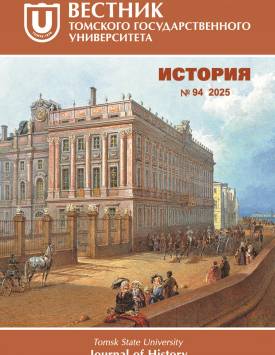Socialism in one city: architectural reconstruction of Anzhero-Sudzhensk in the context of Soviet urbanization (late 1920s and 1930s)
The paper examines the architectural and urban development of one of the major industrial centers of Kuzbass, Anzhero-Sudzhensk, during the late 1920s and 1930s. The formation of Anzhero-Sudzhensk began in the 1890s, when Anzherskiye and Sudzhenskye coal mines were founded during the construction of the Trans-Siberian Railway. In the following decade, these mines became the largest coal mining enterprise in Siberia. Mining settlements spontaneously grew around them. In 1928, the settlements of Anzherka and Sudzhenka were united into Anzhero-Sudzhensky work settlement, which was transformed into a city three years later. Despite various administrative transformations, the appearance of Anzhero-Sudzhensk in those years was far from urban. This settlement was a group of workers' “colonies”, which testified to the unfinished nature of the urbanization transition. The housing issue was an acute problem in the life of Anzhero-Sudzhensk. In the late 1920s, local mines were included in the Ural-Kuznetsk Combine, a future interregional industrial complex. Forced industrialization entailed a rapid activation of urbanization processes. In 1930, the process of urban space changes was initiated, which can be called the “architectural reconstruction” of Anzhero-Sudzhensk. In the early 1930s, the architectural development of the city was carried out under the influence of Constructivism, an avant-garde architectural movement. Since the late 1920s, Anzhero-Sudzhensk has been enriched with a number of new large buildings: a hospital complex, several schools, a workers' club, mechanized dining facilities, and the House of Soviets. Without a doubt, these buildings gave a more urbanized appearance to the city, but housing construction still lagged far behind the needs of citizens. Instead of mass housing, the construction of elite houses for the “labor aristocracy” began. The reconstruction of Anzhero-Sudzhensk was half-hearted from the very beginning. It was caused by the dominance of departmental interests, the residual principle of civil construction financing, limited capabilities of local authorities, and delays in developing of the city general plan. Nevertheless, new public, industrial and residential buildings played an important role in the process of urbanization transition in Anzhero-Sudzhensk. They contributed to the making of the “Soviet citizen” and determined the new appearance of the city. The author is deeply grateful to Daria Nesmeyanova and Karina Lyanikova for their assistance in finding sources and valuable additions. The author declares no conflicts of interests.
Keywords
Anzhero-Sudzhensk,
Kuzbass,
Soviet urbanization,
architectural and urban development,
ConstructivismAuthors
| Atapin Ivan I. | Tomsk State University | ivatapin@gmail.com |
Всего: 1
References
Захарова И.В. Архитектурное наследие Кузбасса 1910-1930-х гг. : материалы к своду памятников архитектуры Кемеровской области. Кеме рово : АРФ, 2005. 104 с.
Духанов С.С. Проблемы «недостроенного города» в Западной Сибири 1930-х гг. // Сибирские исторические исследования. 2017. № 2. С. 38-55.
Кружинов В.М., Сокова З.Н. Сибирский город в начале «великого перелома» (на материалах Тюмени) // Вестник Томского государственно го университета. История. 2021. № 72. С. 50-57.
Атапин И.И. Социалистический город Тырган: историко-архитектурный очерк // Вестник Томского государственного университета. Исто рия. 2023. № 82. С. 20-26. doi: 10.17223/19988613/82/2.
Анищенко Е.А. Этапы формирования города Анжеро-Судженска на базе промышленных производств (конец XVIII - XIX вв.) // Ноэма (Ар хитектура. Урбанистика. Искусство). 2019. № 3. С. 9-16.
Сенявский А.С. Урбанизация России в XX веке: роль в историческом процессе. М. : Наука, 2003. 286 с.
Нагнибеда В.Я. Томская губерния : стат. очерк. 2-е доп. изд. Томск : Нар. тип. № 3, 1921. Вып. 2. 27 с.
Шнейдер А.Р. Округа и районы Сибирского края. Новосибирск : Сибкрайиздат, 1930. 158 с.
Санитарное состояние Анжеро-Судженского района. Жилищные условия и рабочие поселки // Красное знамя. 1924. 4 нояб.
Трофимович П. Пути к оздоровлению быта // Красное знамя. 1926. 3 июля.
Тихомиров Б. Строительство городов Кузбасса // Коммунальное дело. 1930. № 3. С. 80-83.
Государственный архив Новосибирской области (ГАНО). Ф. Р-1353. Оп. 1. Д. 51.
ГАНО. Ф. Р-1353. Оп. 1. Д. 59.
Смирнов П. Товарищ Семашко на копях // Красное знамя. 1928. 7 июня.
Циприс Б. Города Кузбасса // Вторая угольная база СССР Кузбасс : сб. ст. / под общ. ред. М.С. Строилова. Новосибирск [и др.] : Гос. ОНТИ, 1936. Ч. 2, кн. 2: Техника производства и экономика Кузбасса. С. 250-270.
[Проект электростанции в Анжерке] // Советская Сибирь. 1929. 6 сент.
Теплов Н. По ходатайству Надежды Константиновны // Борьба за уголь. 1969. 26 февр.
Новосибирский городской архив. Ф. 798. Оп. 5. Д. 5.
Общественное питание у горняков не двигается с места // Красное знамя. 1928. 3 янв.
Из-под власти кухни // Красное знамя. 1929. 3 марта.
В Судженке на шахте 5-7 открылась столовая на 4 000 обедов // Красное знамя. 1930. 13 апр.
1 мая в Анжерке открылась столовая на 400 человек // Красное знамя. 1930. 6 мая.
ГАНО. Ф. Р-204. Оп. 3. Д. 758.
[Проект Дома Советов] // Борьба за уголь. 1934. 20 мая.
Плотников В. Контора пишет.. // Советская Сибирь. 1935. 24 июля.
В обл- и крайисполкомах // Наше строительство. 1936. № 23. С. 40-41.
Невзгодин И.В. «Музыка будущего» - дипломный проект Н.С. Кузьмина // Николай Кузьмин : к 100-летию со дня рождения : сб. ст. и материалов. М., 2005. С. 113-134.
Дом шахтеров-ударников // Советская Сибирь. 1934. 12 нояб.
Благоустройство города в цифрах // Борьба за уголь. 1934. 21 нояб.
Иванов С. Дом на Судженке // Советская Сибирь. 1935. 18 янв.
Христолюбов [М.П.]. Город Анжеро-Судженск // Социалистический город. 1935. № 12. С. 25-26.
[Дом специалистов, выстроенный на 10-й колонии] // Борьба за уголь. 1936. 15 нояб.
Открытое письмо бригады тов. Моргунова // Борьба за уголь. 1933. 12 окт.
Суд // Борьба за уголь. 1935. 12 июля.
Чуг. В. Будущее лицо Анжеро-Судженска (проект реконструкции города) // Борьба за уголь. 1934. 8 апр.
Малкин Г. Планировка и строительство городов Кузбасса // Советская Сибирь. 1939. 29 сент.
Рабочий класс Сибири в период строительства социализма (1917-1937 гг.). Новосибирск : Наука, 1982. 425 с.
Новосибирская область: экономико-географическое описание. Новосибирск : Новосиб. обл. изд-во, 1939. 250 с.
Мрачковский В.И. Город на угле. Из дневника // Сибирские огни. 1935. № 1. С. 213-230.

